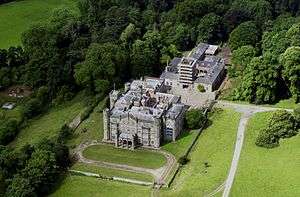Apley Hall

Apley Hall is an English Gothic Revival house located in Stockton, Shropshire. The building was completed in 1811 with adjoining property of 180 acres (0.73 km2) of private parkland beside the river Severn. It was once home to the Whitmore, Foster and Avery families. The Hall is a Grade II* listed building[1] claimed as one of the largest in the county of Shropshire.
History
The Whitmore family had been feudal landowners of Apley since 1572 [2] when the manor was purchased by William Whitmore (d. 1593), a haberdasher of London. The will of William Whitmore, dated 6 August 1593 records:[3]
ANNO 36 ELIZABETH. Monday next after the Feast of S. Ambrose, Bishop [4 April] Whitmore (William), haberdasher.—To George, William, and Thomas his sons he leaves the manor or lordship of Stockton, co. Salop, and his lands, tenements, &c., at Stockton, Apley, Hickford, Astley, and Norton, co. Salop, by equal thirds, in several tail, with cross remainders; remainder to Elizabeth, Anne, Margaret, Mary, "Francis," and Jane his daughters. Provision made against cutting off the entail. To Anne his wife the farm called "Balmes," (fn. 14) situate in the parishes of Hackney, Shorditch, and Tottenham, for life; remainder to all his children equally. Dated 6 August, 35 Elizabeth [A.D. 1593]. Roll 274 (15).
William Whitmore's eldest son was Sir William Whitmore of Apley, knight, High Sheriff of Shropshire in 1620, and his second son was Sir George Whitmore (d. 1654), Lord Mayor of London. Sir William resided at Apley and in 1634 purchased the manor of Balmes in Hackney, held under a lease by his father, for his brother Sir George, who there received King Charles I in 1641.[4] Sir William's son and heir was Sir Thomas Whitmore, 1st Baronet (d. 1653).
The existing Georgian style house was remodeled during the Regency period in Neo-Gothic style between 1808 and 1811 for Thomas Whitmore, High Sheriff of Shropshire in 1806 and Member of Parliament for Bridgnorth 1806–31. It incorporated a faux chapel, hexagonal turrets and battlements.[1] Design work is attributed to members of the architectural family of Thomas Wyatt and construction work was undertaken by the Carline family of Shrewsbury.
In 1867, the Foster family purchased the property for a record amount and remodelled it during a revival of Gothic style in the Victorian period. Famous English eccentric Gerald Tyrwhitt-Wilson, 14th Baron Berners was related to the Fosters (as a grandson of William Orme Foster, the purchaser) and was born at Apley in 1883. The Hall and Estate remained in Foster family ownership until 1960 when the last incumbent of the Foster family died.
Due to the vastness of the house and its substantial upkeep it was difficult to find a family willing to occupy Apley Hall and so alternative uses were sought. In 1962 the house became a state secondary modern boarding school run by Shropshire County Council and remained so until its closure in 1987.
Apley Hall remained empty and suffered a great deal of deterioration and vandalism during the following ten years and was listed on the English Heritage Buildings at Risk Register. In 1997 the house was bought by Neil Avery, an entrepreneur and conservation specialist as a family home. The house was restored and subsequently removed from the Buildings at Risk Register.
There had long been speculation that Jeeves and Wooster author P.G.Wodehouse had based his fictitious Blandings Castle on Apley. In 2003, Dr Daryl Lloyd and Dr Ian Greatbatch (two researchers in the Department of Geography and Centre for Advanced Spatial Analysis, University College London) made use of a Geographic Information System to analyse a set of geographical criteria, such as a viewshed analysis of The Wrekin and drive time from Shrewsbury. Their final conclusion was that Apley was the best suited location for fulfilling the geographical criteria.
During 2004 the house was sold to specialist developers who have since divided the Hall into several self-contained houses.
References
- 1 2 Images of England: architectural description of listed building Archived 25 October 2012 at the Wayback Machine.
- ↑ A Genealogical and Heraldic History of the Commoners of Great Britain John Burke (1836) p409
- ↑ From: 'Wills: 31-40 Elizabeth I (1588-98)', Calendar of wills proved and enrolled in the Court of Husting, London: Part 2: 1358-1688 (1890), pp. 713-725
- ↑ Victoria County History, Middlesex, vol.10, 1995, Hackney, pp.75-91
- Lord Berners: The Last Eccentric, London, 1998 ISBN 978-0-7126-6578-0
- A Wodehouse Handbook vol.1, N.T.P. Murphy
External links
Coordinates: 52°34′52″N 2°25′36″W / 52.58104°N 2.42674°W